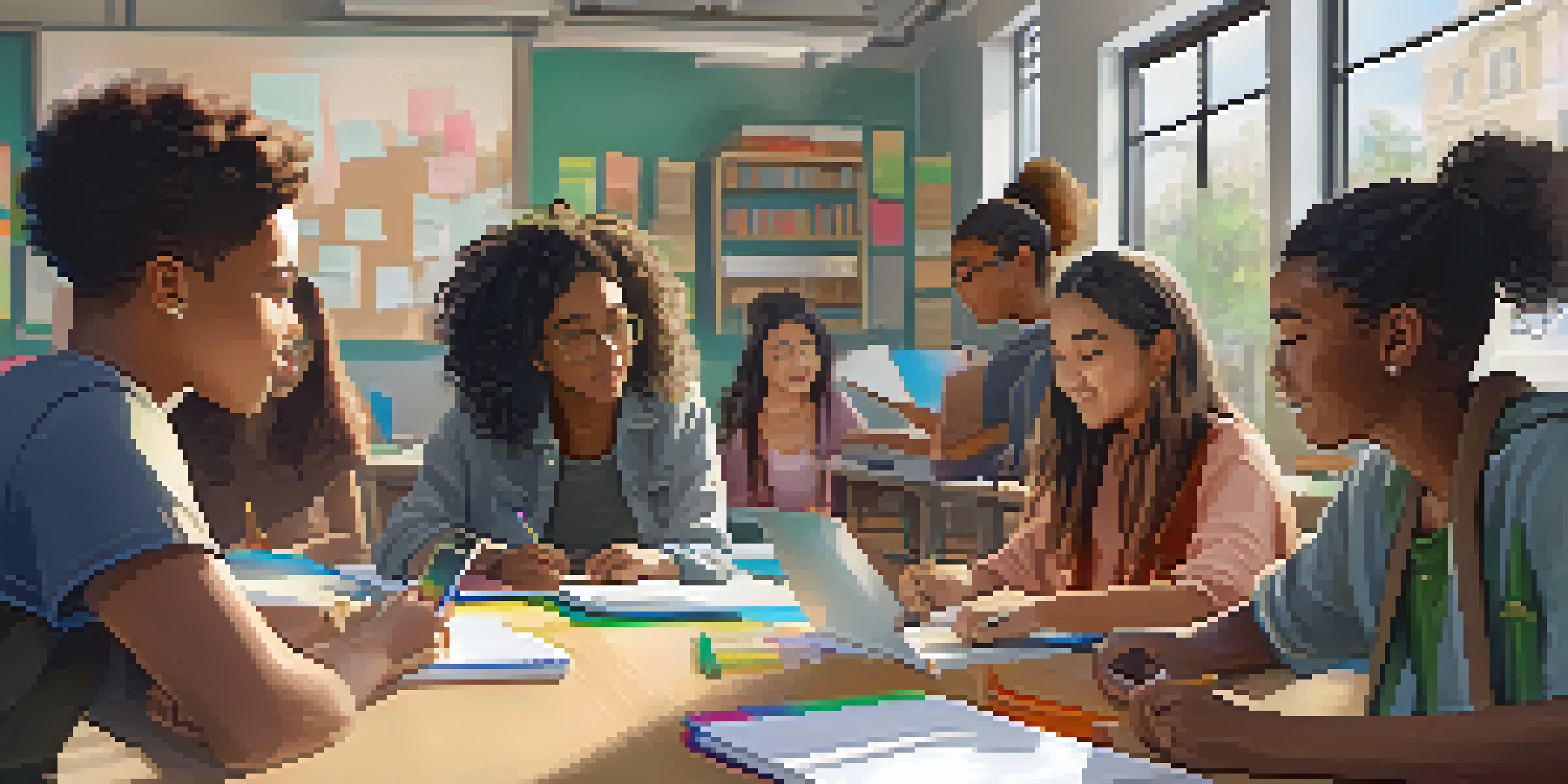The Importance of Active Participation in Collaborative Learning

Understanding Collaborative Learning and Its Benefits
Collaborative learning is an educational approach where individuals work together to achieve shared goals. This method fosters a deeper understanding of the material, as students engage with each other’s perspectives. By discussing concepts and solving problems in groups, learners often find that they grasp complex ideas more readily than when studying alone.
Alone we can do so little; together we can do so much.
The benefits of collaborative learning extend beyond academic achievement. It also cultivates essential life skills such as teamwork, communication, and critical thinking. These are invaluable traits in both personal and professional settings, making collaborative learning a vital part of modern education.
Ultimately, collaborative learning creates a supportive environment where students can learn from one another and grow together. This sense of community not only enhances individual learning but also builds lasting relationships that can benefit students long after they leave the classroom.
The Role of Active Participation in Learning Success
Active participation is key to maximizing the benefits of collaborative learning. When students actively engage in discussions, share ideas, and contribute to group tasks, they reinforce their understanding of the material. This active involvement encourages learners to take ownership of their education, which often leads to better retention of information.

Moreover, active participation fosters a sense of accountability among group members. When everyone contributes, the responsibility for learning is shared, creating a more dynamic and engaging atmosphere. This collective effort means that each participant is more likely to stay motivated and committed to the learning process.
Collaboration Enhances Learning
Working together in groups allows students to deepen their understanding of complex material through shared perspectives and discussions.
In contrast, passive participation can hinder progress and diminish the overall effectiveness of collaboration. Students who simply observe without contributing may miss out on important insights and connections, ultimately limiting their learning experience.
Building Confidence Through Active Engagement
Participating actively in collaborative learning helps build confidence among students. As individuals express their thoughts and ideas, they gain reassurance in their abilities and knowledge. This confidence can significantly enhance their willingness to take risks and engage in more challenging discussions.
The beautiful thing about learning is that no one can take it away from you.
When students feel supported by their peers, they are more likely to share their unique perspectives without fear of judgment. This open dialogue not only enriches the learning experience but also encourages students to value their contributions. Over time, this practice can lead to a more assertive and self-assured learner.
Additionally, the feedback received from peers during these collaborative efforts can further bolster confidence. Constructive criticism and encouragement can motivate students to refine their ideas and push their boundaries, leading to personal growth and improved academic performance.
Enhancing Critical Thinking Skills Through Collaboration
Active participation in collaborative learning environments sharpens critical thinking skills. Engaging in discussions and debates pushes students to analyze information, evaluate different viewpoints, and develop logical arguments. This process encourages them to think deeply and critically about the subject matter.
By working together, students are exposed to a variety of perspectives that challenge their assumptions and broaden their horizons. This diverse input fosters a richer understanding of complex topics, as learners must navigate differing opinions and arrive at consensus. Such experiences are crucial for developing well-rounded critical thinkers.
Active Participation Builds Skills
Engaging actively in collaborative settings fosters essential skills such as critical thinking, communication, and confidence among learners.
Moreover, the collaborative nature of learning allows students to practice problem-solving in real-time. They can experiment with ideas, test hypotheses, and collaboratively work towards solutions, enhancing their analytical skills in the process.
Fostering Effective Communication Skills in Teams
Effective communication is a cornerstone of successful collaboration. Active participation helps students practice articulating their thoughts clearly and listening to others. These skills are essential not only in academic settings but also in professional environments, where teamwork and communication are paramount.
In a collaborative learning scenario, students learn to express their ideas respectfully while also valuing the input of their peers. This mutual respect nurtures an environment where everyone feels comfortable sharing, enhancing the overall quality of discussions. Such skills translate well into real-world situations where collaboration is required.
Furthermore, active engagement encourages students to adapt their communication styles to suit different audiences. Whether discussing with peers, presenting to a group, or engaging with instructors, these experiences cultivate versatile communicators who can thrive in various contexts.
Encouraging Diverse Perspectives and Inclusivity
One of the most enriching aspects of collaborative learning is the diversity of perspectives it brings to the table. Active participation invites students from various backgrounds to share their unique insights and experiences, fostering a richer learning environment. This diversity not only enhances discussions but also broadens students' understanding of the world.
Inclusivity in group work ensures that all voices are heard and valued. By encouraging participation from everyone, educators create a space where students feel respected and empowered. This sense of belonging can lead to increased motivation and a greater willingness to engage in collaborative efforts.
Diversity Enriches Perspectives
Embracing diverse viewpoints in collaborative learning creates a more inclusive environment that broadens students' understanding of the world.
Moreover, embracing diverse perspectives in collaborative learning helps prepare students for a globalized world. In our interconnected society, the ability to understand and appreciate different viewpoints is essential for personal and professional success.
Conclusion: The Lasting Impact of Active Participation
In conclusion, active participation is vital for the success of collaborative learning. It not only enhances individual understanding of the material but also fosters essential skills such as confidence, critical thinking, and effective communication. By engaging fully in collaborative efforts, students prepare themselves for future challenges in both their academic and professional lives.
The benefits of active participation extend beyond the classroom, as the skills developed during collaborative learning are transferable to various aspects of life. From working in teams to navigating complex social dynamics, these lessons stay with students long after they leave school.

Ultimately, cultivating a culture of active participation in collaborative learning environments creates a foundation for lifelong learning and personal growth, empowering students to thrive in a rapidly changing world.